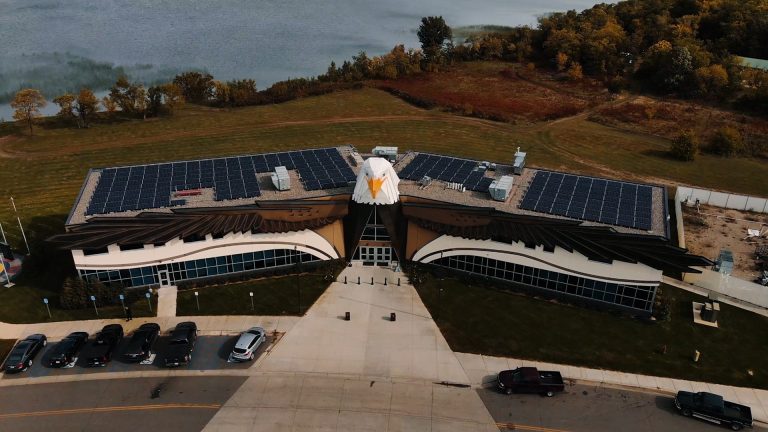Clean Energy Jobs Would Triple by 2050
Average Household Energy Bills Would Decrease by $1,200 per Year
A report released today shows that Minnesota could retire the state’s coal plants, build no additional natural gas plants, and still meet energy demands reliably through clean and renewable energy sources. The report, commissioned by the McKnight Foundation, also shows that the state can meet its greenhouse gas reduction goals while reducing energy costs and tripling clean energy jobs.
The report details how Minnesota can significantly reduce its reliance on fossil fuels by replacing the energy that is currently used in buildings and the transportation sector with clean energy sources to achieve the state’s target for greenhouse gas emissions reductions: 80% by 2050. Minnesota is currently failing to meet its bipartisan carbon reduction goals.
“This report shows that Minnesota can achieve our 2050 greenhouse gas reduction goals across the buildings, energy, and transportation sectors while providing reliable energy at affordable prices,” said Kate Wolford, President of the McKnight Foundation. “Continuing our state’s progress on clean energy will not only allow us to tackle climate change, but will significantly reduce air pollution, increase human health, and boost our economy by tripling the number of energy sector jobs by 2050.”
Read the full report, “Minnesota’s Smarter Grid: Pathways Toward a Clean, Reliable and Affordable Transportation and Energy System.” Read the executive summary.
Why this matters for Minnesota:
- Energy Costs Would Go Down. Electricity rates would decrease by approximately 30% and average households would save approximately $1,200 per year in energy costs.
- Clean Energy Jobs Would Triple. Jobs in the clean energy sector would more than triple, creating an estimated 14,000 jobs in the wind industry and 36,000 jobs in the solar industry by 2050. In fact, jobs, incomes, and state level GDP would all increase under the clean energy scenario.
- Cleaner Air and Healthier Communities. In addition to reducing greenhouse gases, the report shows a significant reduction in other pollutants harmful to human health. This means cleaner air and healthier communities.
- Powering the transportation and heating sectors with clean energy provides significant pollution reduction. While the state’s electric generation has been getting cleaner, Minnesota has not been making progress in its transportation and heating sectors. The report shows scenarios to reliably power heating and transportation with clean electricity, reducing greenhouse gas emissions from these sectors.
“Clean energy helps sustain what we love most about our state, which in turn attracts and retains businesses and employees.”
-TRENT MOSTAERT, VICE PRESIDENT AND GENERAL MANAGER, MORTENSON
What businesses are saying:
“For our region to remain competitive and have a high quality of life, our members have said it is vital for Minnesota to move toward an energy system that is 100 percent renewable,” said Amy Fredregill, Minneapolis based nonprofit Environmental Initiative’s Managing Director of the Minnesota Sustainable Growth Coalition, a business-led partnership of 31 Minnesota-based organizations harnessing their expertise to advance the next frontier of corporate sustainability. “This report provides science-based, data-driven approaches to reaching that goal while benefitting Minnesota’s economy and the people who live here.”
“Significantly increasing our production of clean energy presents Minnesota with tremendous environmental and economic opportunities, and we are pleased to be a part of this continuing energy journey,” said Trent Mostaert, Vice President and General Manager at Mortenson. “Clean energy helps sustain what we love most about our state, which in turn attracts and retains businesses and employees. This report reinforces that clean energy is the right choice for Minnesota’s economy.”
What consumer groups are saying:
“Minnesota’s utilities have an obligation to provide customers with the most reliable and cost-effective energy they can, this report shows that clean energy meets those criteria,” said Annie Levenson-Falk, Executive Director of the Citizens Utility Board. “Utilities should move aggressively toward carbon free energy—it’s the best option for consumers.”
What scientists are saying:
“It is heartening to see this report that presents various scenarios under which the Minnesota economy can be heavily decarbonized, leading to lower cost of electricity to consumers, cleaner air and creation of new jobs,” said Ned Mohan, Oscar A. Schott Professor of Power Electronics and Systems in the Department of Electrical and Computer Engineering, University of Minnesota. “As this study points out, this can only be accomplished by shifting most of our energy use to electricity, and then generating it from renewables. This would undoubtedly require our continuing ingenuity and creativity.”
“Minnesota’s Smarter Grid: Pathways Toward a Clean, Reliable and Affordable Transportation and Energy System” was modeled and authored by Vibrant Clean Energy. GridLab provided project management, and the McKnight Foundation sponsored the study. The study modeled electric sector scenarios to determine optimal pathways to the significant decarbonization of Minnesota’s economy.
###
About Vibrant Clean Energy: A nationally recognized energy grid modeling firm based in Colorado. VCE creates computer optimization software to study pathways for energy systems futures. It also performs studies using WIS:dom to provide expertise in new arenas of electrification, decarbonization and variable resources. The mission of VCE is to help facilitate universal, sustainable, and cheap energy for everyone.
About the McKnight Foundation: A Minnesota-based family foundation, seeks to improve the quality of life for present and future generations. Program interests include regional economic and community development, Minnesota’s arts and artists, education equity, youth engagement, Midwest climate and energy, Mississippi River water quality, neuroscience research, international crop research, and rural livelihoods. Founded in 1953 and independently endowed by William and Maude McKnight, the Foundation has assets of approximately $2.3 billion and grants about $90 million a year.
About GridLab: A national non-profit that provides comprehensive and credible technical expertise on the design, operation, and attributes of a flexible and dynamic grid to assist policy makers, advocates, and other energy decision makers in navigating the energy transformation
MEDIA CONTACT
Alexandra Fetissoff, (908) 456-7070



